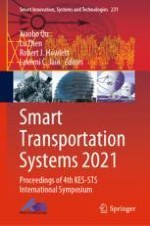2021 | OriginalPaper | Buchkapitel
Modeling Commercial Vehicle Drivers’ Acceptance of Forward Collision Warning System
verfasst von : Yueru Xu, Zhirui Ye, Chao Wang, Kun Gao
Erschienen in: Smart Transportation Systems 2021
Verlag: Springer Singapore
Aktivieren Sie unsere intelligente Suche, um passende Fachinhalte oder Patente zu finden.
Wählen Sie Textabschnitte aus um mit Künstlicher Intelligenz passenden Patente zu finden. powered by
Markieren Sie Textabschnitte, um KI-gestützt weitere passende Inhalte zu finden. powered by
